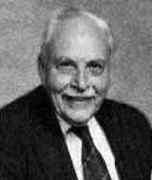Person: Hall Jr, Marshall

Marshall Hall, Jr was an American mathematician who made important contributions to group theory and combinatorics.
Mathematical Profile (Excerpt):
- Marshall Hall Sr. was educated in private schools in Kentucky and was first employed by the Chesapeake & Ohio Railroad Company.
- Marshall Hall Sr. worked his way up to become president of the W L Green Commission Company in 1903.
- In 1915 the company was renamed the Marshall Hall Grain Company, with Marshall Hall Sr. as its president.
- Marshall Hall Jr showed talent for mathematics at a young age for, at age eleven, he constructed a seven-place table of logarithms for the positive integers up to 1000.
- Marshall was taught mathematics by a good teacher although he was not a mathematician, being employed as a German teacher.
- At Cambridge he was taught by several mathematicians who were to have an important influence on him such as Philip Hall, Harold Davenport and G H Hardy.
- After the award of his Ph.D., Hall spent the year 1936-37 at the Institute for Advanced Study at Princeton.
- We shared space in Fine Hall with the Mathematics Department.
- While at the Institute for Advanced Study, Hall received offers of an Instructorship in Mathematics from Columbia University and a similar offer from Yale University.
- With the United States now at war, Hall joined Naval Intelligence and was involved, as were many other mathematicians, deciphering Japanese coded messages and deciphering German Enigma codes.
- Hall spent six months at Bletchley Park, the centre for British Intelligence, during 1944.
- Hall's 48-page paper Projective planes was published in the Transactions of the American Mathematical Society in 1943.
- Hall, therefore, accepted an appointment as an associate professor at Ohio State University and began teaching there in the autumn of 1946.
- Saunders Mac Lane had recommended Hall to Tibor Radó, the chairmen of the Ohio State Mathematics Department, who treated him very well.
- Hall is best known as a group theorist, perhaps because of his famous book Theory of Groups (1959) from which several generations of group theorists have learnt the subject.
- He was writing this book during his year in Cambridge and Philip Hall read his manuscript and made many helpful suggestions.
- Hall spent time at the University of Warwick Group Theory year in August 1967 and, while in England, visited Philip Hall in Cambridge.
- This group is now known as the Hall-Janko group.
- The uniqueness of the simple group of this order was proved in Hall's paper, written jointly with David Wales, The simple group of order 604,800 (1968).
- We should go back a little at this point and look at some of Hall's other contributions to group theory.
- When P Hall found himself unable to return to the plan, M Hall, Jr used his wide experience in group theory to fill his place and to explain the theoretical background of the construction.
- In 1973 Hall was named IBM Professor at CalTech but, in 1977, he arranged for his appointment at CalTech to be half-time so that he could spend time in other institutions.
- Among the honours Hall received were two Guggenheim Fellowships and membership of the American Academy of Arts and Sciences.
- The Marshall Hall Conference was held at the University of Vermont, Burlington, Vermont, September 13-18, 1990.
- The original impetus for the conference was to celebrate the 80th birthday of Marshall Hall.
Born 17 September 1910, St Louis, Missouri, USA. Died 4 July 1990, London, England.
View full biography at MacTutor
Tags relevant for this person:
Algebra, Group Theory, Origin Usa, Puzzles And Problems
Thank you to the contributors under CC BY-SA 4.0! 

- Github:
-

- non-Github:
- @J-J-O'Connor
- @E-F-Robertson
References
Adapted from other CC BY-SA 4.0 Sources:
- O’Connor, John J; Robertson, Edmund F: MacTutor History of Mathematics Archive
